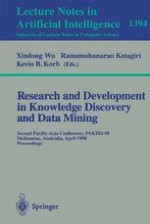1998 | Buch
Research and Development in Knowledge Discovery and Data Mining
Second Pacific-Asia Conference, PAKDD-98 Melbourne, Australia, April 15–17, 1998 Proceedings
herausgegeben von: Xindong Wu, Ramamohanarao Kotagiri, Kevin B. Korb
Verlag: Springer Berlin Heidelberg
Buchreihe : Lecture Notes in Computer Science
Enthalten in: Professional Book Archive
